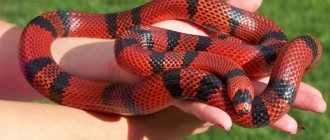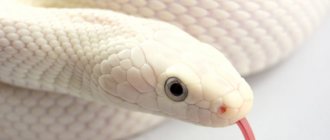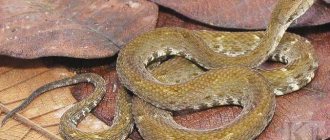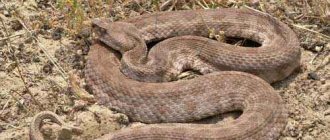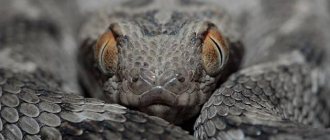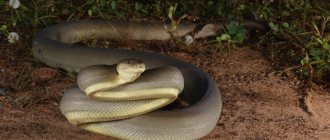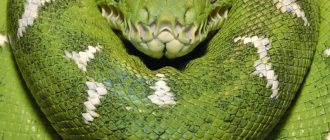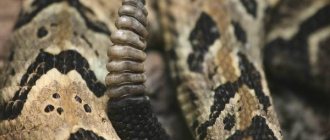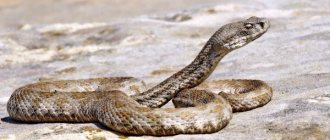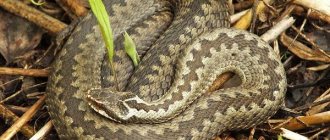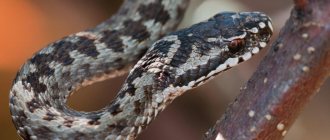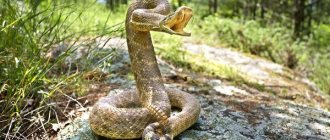Snakes are beautiful creatures that exude beauty and mystery. Despite outward calm, snakes can carry out a sudden attack, and their bite can be fatal. Brightly colored snakes are often the most venomous and include yellow snakes.
Contrary to popular belief, not all yellow snakes are poisonous. We will consider this and other questions further in our article.
Appearance
The body of the yellow snake is elongated and can reach several meters in length. Generally, females are longer than males, but males have longer tails.
The weight of a snake, depending on the species, can be from 10 grams to 100 kilograms. The body is completely or partially colored in various shades of yellow.
Description
Sand ephs are representatives of the viper family, and these snakes are recognized not only as the most poisonous reptiles in nature, but also as the crown of evolution among this order. The small efa, despite its bewitching and harmless appearance and fairly calm character, is capable of poisoning an enemy in just a few moments: it takes its rightful place in the top ten most poisonous snakes. Its poison is so strong that even timely administration of the serum will not protect you from health problems for the rest of your life.
This poison can cause unstoppable bleeding at the site of the bite, which is accompanied by bleeding from the mucous membranes of the mouth and eyes, as well as hemorrhage into the internal organs. According to statistics, at least 20% of all victims die from the bite of the sand ephas, while the rest can be saved by administering the serum.
The sand epha is a medium-sized reptile - up to a maximum of 76 cm in length - twice as small as the same cobra or viper. One of the identifying features of this species is a zigzag light stripe along the length of the entire body. There must be white spots (back and head) - and the brightness of the spots differs in different subspecies of this snake.
The scales of these reptiles are small, with quite noticeable protruding ribs in the back area. On the sides, the snake’s body is equipped with several rows (up to five) of small scales directed diagonally downward, which are framed by jagged ribs. These scales serve as a kind of musical accompaniment, thanks to which the snake creates a certain warning signal, similar to a hissing rustling sound.
Unlike other snakes, the sand epha moves on quick sand differently than all reptiles, i.e. wave-like, but in a lateral motion, which is accompanied by sharp throws of the body in a certain direction. It looks memorable and unusual: the snake first throws its head away, then sharply pulls the back part of its body towards it, and only then the front part follows. As a result of this unusual method of movement, a clear trace of oblique stripes with curled ends can be found on the sand.
Already ordinary
Externally it is a black or gray snake with a yellow head. The body is on average 70 centimeters long, but in rare cases it can reach 1.5 meters.
The back is painted grayish-black. There are two bright yellow spots on the head. It lives in temperate latitudes of Europe and Asia.
The yellow-headed snake feeds on fish and amphibians. Non-toxic, therefore safe for humans. In rare cases, it may bite. When in danger, he prefers not to attack, but to hide.
Black Mamba
Africa's deadliest snake, the black mamba (Dendroaspis polylepis) can kill a human with just two drops of venom.
Black Mamba
Named for the dark, inky color inside their mouths, black mambas are actually brownish in color. Their average length is about 2.5 meters, and their speed is 19 km/h.
These long snakes are born with two or three drops of venom on each fang. That's why they bite fatally from the very beginning. By adulthood, they can accumulate up to 20 drops in each fang. (Reported by Kruger National Park). Without treatment, the bite of this African snake is almost always fatal.
Black Mamba
Here's what black mamba venom does to your body: Once injected, the venom disrupts activity at the junction of nerves and muscles. All this leads to paralysis. (Reported by Ryan Blumenthal of the University of Pretoria in The Conversation). Since the venom is also cardiotoxic, it can lead to cardiac arrest.
This happened to one South African, whose index finger was bitten by a black mamba, reports Blumenthal. By the time he got to the hospital, he had already gone into cardiac arrest within 20 minutes. Despite the fact that doctors injected him with antivenom, the man died a few days later.
- Habitat: Africa
Scientists don't know exactly how many people the black mamba kills each year. However, Blumenthal estimates that it is responsible for the largest number of snake deaths in southern Africa.
Malayan (ribbon) krait, or pama
The body of this snake can reach 2 meters in length and has a triangular shape, as can be seen from the photo of the yellow snake.
A distinctive feature is the color - transverse black stripes on a bright yellow background. The Malayan krait lives in Northeast India, South China, and Southeast Asia.
Pama is a nocturnal predator. It feeds on snakes, lizards, amphibians and small mammals. The Malayan krait is one of the most poisonous - the average dose of its toxic poison kills 10 people!
Coastal taipan
The coastal taipan has the second most powerful poison in the world. The average size of a snake varies between 180 cm and 190 cm, but the largest individuals can reach 2 m or even 3 m in length. The color is uniform - brown or reddish. The snake is armed with 13 mm fangs.
The coastal taipan lives on the northern coast of the Australian state of Queensland, the coast of the Northern Territory and the south of New Guinea. Although the coastal taipan's venom is inferior in toxicity to its inland counterpart, this reptile is much more dangerous than McCoy's taipan.
Coastal taipan: Wikipedia
This representative of the asp family is very aggressive and can be easily provoked into attacking. He attacks the victim with lightning speed, inflicting several blows at once. The snake's venom causes muscle paralysis and bleeding disorders. Even with proper medical care, 50% of bites are fatal.
Tiger snake
The average body length of this snake is 1.5 meters. The body coloring resembles that of a tiger. The abdomen is yellow, the back is black with yellow stripes.
The range of the tiger snake is Australia and New Guinea. It feeds on large insects, amphibious lizards, and small mammals. Its poison is deadly to animals and humans. Small animals die within a few seconds.
Value by day of week
| Day | Interpretation |
| From Monday to Tuesday | Meeting with like-minded people ahead |
| From Tuesday to Wednesday | You will have to become a participant in a funny situation |
| From Wednesday to Thursday | Plans will have to change |
| From Thursday to Friday | Worries and doubts are in vain |
| From Friday to Saturday | The appearance of a patron who will help solve difficult issues |
| From Saturday to Sunday | Participation in a new project |
| From Sunday to Monday | Meeting with distant relatives |
snake poison
Snake venom is a colorless or yellowish odorless liquid consisting of peptides and proteins of varying levels of complexity, enzymes, neurotoxins, lipids, amino acids and other substances.
The toxic effect of snake venom is caused by enzymes that can break down tissue in the human body.
For example, hyaluronidase breaks down connective tissue, and phospholipase breaks down red blood cells.
Snake venom may contain neurotoxins that cause paralysis of the respiratory muscles. As a result, the person dies from suffocation.
Bitten by a yellow snake - what to do
As soon as the snake has bitten, it is necessary to immediately (within 1-2 minutes after the bite) suck out the poison from the wound, pressing it from the edge.
The poison must be spat out immediately. In this way, half of the poison that has entered the tissue can be removed.
However, there is no need to panic. When a person panics, the heartbeat quickens, as a result, the poison spreads faster throughout the body.
Then you need to apply a clean bandage to the wound and send the person to the hospital. It is imperative to remember the distinctive features of the snake so that the doctor selects the correct anti-snake serum.
Keeping at home
The species of snake in question is quite demanding when kept in captivity, so it is very rarely raised at home. However, there are exotic lovers who are not averse to acquiring such a dangerous reptile, but it is important to follow the rules of caring for it.
Arrangement of the terrarium
The terrarium will become a home for the pet, so the quality of life of the snake will directly depend on its size and arrangement.
The size depends on the length of the pet: the reptile must move freely around the terrarium.
The temperature should be 25–30 °C with a humidity of 90% - it is necessary to install special humidifiers.
Important! Most kraits are nocturnal animals, so their home should be located away from daylight.
In addition to bedding in the form of large wood shavings, the terrarium must be equipped with additional entertainment and shelters. You can put various driftwood, branches, stones. The main thing is that these decorations are smooth and natural.
Feeding
To feed an exotic pet, you must purchase mice or small reptiles from a specialized store. Frozen rodents are very popular - they must be thawed before feeding. The frequency of feeding depends on the breed: smaller representatives eat mice once a week, larger ones - once every 2 weeks or month, and the mice should be larger in size than in the first case.
Photos of yellow snakes
https://youtu.be/l_TqkWj_f9A
